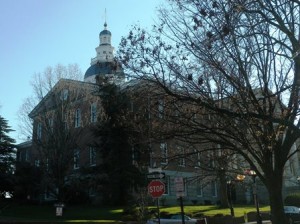‘Annapolis’ Category
» posted on Friday, December 6th, 2013 by Linda Lou Burton
Staying Alive And The Final Five
 Linda Burton posting from Annapolis, Maryland – Psychologically we love countdowns. We count down the twelve days till Christmas. We countdown rocket launches, till we arrive at blastoff, or the mission is scrubbed. We countdown the Final Four in basketball every spring, when the world of college sports reaches fever pitch. I counted down the days in the month before my 16th birthday; I was on pins and needles to get my driver license; something everyone in my little town did back in the 50s when all the cars had fins and all the girls wore bobby socks. The year I went to Antarctica – that was 2005 – I counted off the weeks till my Seattle departure at Pagliacci Pizza. I happened to go for a Friday
Linda Burton posting from Annapolis, Maryland – Psychologically we love countdowns. We count down the twelve days till Christmas. We countdown rocket launches, till we arrive at blastoff, or the mission is scrubbed. We countdown the Final Four in basketball every spring, when the world of college sports reaches fever pitch. I counted down the days in the month before my 16th birthday; I was on pins and needles to get my driver license; something everyone in my little town did back in the 50s when all the cars had fins and all the girls wore bobby socks. The year I went to Antarctica – that was 2005 – I counted off the weeks till my Seattle departure at Pagliacci Pizza. I happened to go for a Friday  night pizza at the 17-week point and noticed they had 17 pizzas on their menu. “Aha,” I thought, “if I begin with the Original, when I get to the Verde Primo it will be time to fly to South America.” I called for grandson help on big-meat pizza nights; Matthew for Spicy Pepperoni; Andrew for Extra Pepperoni; both of them on Grand Salami Primo night. The AGOG was my favorite – mushrooms, roasted garlic, Kalamata olives, goat cheese, Fontina, Mozzarella and parsley over olive oil; fresh tomato slices added after the bake. The journey through the Pagliacci menu
night pizza at the 17-week point and noticed they had 17 pizzas on their menu. “Aha,” I thought, “if I begin with the Original, when I get to the Verde Primo it will be time to fly to South America.” I called for grandson help on big-meat pizza nights; Matthew for Spicy Pepperoni; Andrew for Extra Pepperoni; both of them on Grand Salami Primo night. The AGOG was my favorite – mushrooms, roasted garlic, Kalamata olives, goat cheese, Fontina, Mozzarella and parsley over olive oil; fresh tomato slices added after the bake. The journey through the Pagliacci menu  was an experience; I developed new tastes, and learned some things I didn’t know before. I dealt with whatever came next; I adapted as needed. You know where I’m going with that thought. Annapolis finishes the countdown through the Final Five; the Journey Across America is 100% complete. This mission wasn’t scrubbed; we made it all the way (adapting as needed) – the Scion, the cats, and me. We’re travelworn and frazzled, but completely AGOG with success. » read more
was an experience; I developed new tastes, and learned some things I didn’t know before. I dealt with whatever came next; I adapted as needed. You know where I’m going with that thought. Annapolis finishes the countdown through the Final Five; the Journey Across America is 100% complete. This mission wasn’t scrubbed; we made it all the way (adapting as needed) – the Scion, the cats, and me. We’re travelworn and frazzled, but completely AGOG with success. » read more
» posted on Sunday, December 1st, 2013 by Linda Lou Burton
Her Name Is Joy
 Linda Burton posting from Annapolis, Maryland – “I’m definitely celebrating today,” I confided to the woman beside me on the bench. We were waiting for a table at Miss Shirley’s, where you couldn’t stir the brunch crowd with a stick and most of the conversations were celebrating football wins. She was from Savannah; her brother lived in Athens; she was beaming about Georgia’s victory over Tech; 41-34. Her husband, who was graciously standing so I could sit, was from Florida; he was equally pleased with FSU; Seminoles 37 – Gators 7. I’d watched Saturday’s football too; not the least concerned that the Crimson Tide would do its usual thing, and win the Iron Bowl. But, in the craziest ending in the history of football, a last-second 100-yard run by Auburn’s Chris Davis put a different result in the record books; Auburn 34 – Alabama 28. A shocker, yes; but even that couldn’t dampen my mood this week; I’d been overjoyed since Friday and that was that. I moved the conversation from football to the reason for my happiness. “Annapolis is my 50th! I made it! I actually frigging made it to all 50 capital cities!” This brought a puzzled look; I handed her a card showing my name and website address and went on to explain the
Linda Burton posting from Annapolis, Maryland – “I’m definitely celebrating today,” I confided to the woman beside me on the bench. We were waiting for a table at Miss Shirley’s, where you couldn’t stir the brunch crowd with a stick and most of the conversations were celebrating football wins. She was from Savannah; her brother lived in Athens; she was beaming about Georgia’s victory over Tech; 41-34. Her husband, who was graciously standing so I could sit, was from Florida; he was equally pleased with FSU; Seminoles 37 – Gators 7. I’d watched Saturday’s football too; not the least concerned that the Crimson Tide would do its usual thing, and win the Iron Bowl. But, in the craziest ending in the history of football, a last-second 100-yard run by Auburn’s Chris Davis put a different result in the record books; Auburn 34 – Alabama 28. A shocker, yes; but even that couldn’t dampen my mood this week; I’d been overjoyed since Friday and that was that. I moved the conversation from football to the reason for my happiness. “Annapolis is my 50th! I made it! I actually frigging made it to all 50 capital cities!” This brought a puzzled look; I handed her a card showing my name and website address and went on to explain the  Journey, the research, and the cats. “Well that is awesome,” she grinned, just as their table was called. “I didn’t get your names,” I said as they walked away. “My name is Joy and this is ….” was all I heard as they rounded the corner. My table was ready shortly; I settled in and ordered a Spicy Shirley like I’d seen up front; holiday red; unbelievably huge. A couple soon was seated to my right; another to my left; my Fried Green Tomato appetizer arrived; the party was on. » read more
Journey, the research, and the cats. “Well that is awesome,” she grinned, just as their table was called. “I didn’t get your names,” I said as they walked away. “My name is Joy and this is ….” was all I heard as they rounded the corner. My table was ready shortly; I settled in and ordered a Spicy Shirley like I’d seen up front; holiday red; unbelievably huge. A couple soon was seated to my right; another to my left; my Fried Green Tomato appetizer arrived; the party was on. » read more
» posted on Friday, November 29th, 2013 by Linda Lou Burton
By George
 Linda Burton posting from Annapolis, Maryland – Before you read this post, look at the column to the right. On the dark blue background is a list of capital cities. Count them. You will find 50 capital cities listed now, because at 2:26 PM today, the cats and I arrived in Annapolis, capital city #50 on the Journey Across America. By George, we made it! I parked in front of the Robert Johnson building on the tight little circle street that surrounds the Maryland State House, and jumped out to record the moment with pictures. When I got back Jack was sitting on top of his carrier,
Linda Burton posting from Annapolis, Maryland – Before you read this post, look at the column to the right. On the dark blue background is a list of capital cities. Count them. You will find 50 capital cities listed now, because at 2:26 PM today, the cats and I arrived in Annapolis, capital city #50 on the Journey Across America. By George, we made it! I parked in front of the Robert Johnson building on the tight little circle street that surrounds the Maryland State House, and jumped out to record the moment with pictures. When I got back Jack was sitting on top of his carrier,  watching people walk by on the sidewalks of Annapolis; Alex was perched like a king on his pillow, unimpressed. “Do you think you’re King George?” I laughed. “You don’t want to acknowledge the feisty colonists?” It felt as though King George could be lurking around the corner; if, that is, King George had ever left England, and, if there weren’t so many 21st-century automobiles crowding the narrow brick-paved streets. We were in what is officially named the “Colonial Annapolis Historic District,” where 18th-century buildings remain much as they were when built. To my left the Maryland State House occupies the city’s highest hill; from that point all streets radiate outward; dropping down towards the
watching people walk by on the sidewalks of Annapolis; Alex was perched like a king on his pillow, unimpressed. “Do you think you’re King George?” I laughed. “You don’t want to acknowledge the feisty colonists?” It felt as though King George could be lurking around the corner; if, that is, King George had ever left England, and, if there weren’t so many 21st-century automobiles crowding the narrow brick-paved streets. We were in what is officially named the “Colonial Annapolis Historic District,” where 18th-century buildings remain much as they were when built. To my left the Maryland State House occupies the city’s highest hill; from that point all streets radiate outward; dropping down towards the  waterfront; leading in the other direction towards the countryside. One thing is clear; when this city was laid out, it was intended that all roads lead to the focal point of government – the Maryland State House, the “oldest in the nation still in legislative use” as it so proudly claims. And here the presence of our most beloved “George” remains – George Washington, of course. “This is a living history book,” I said to the cats. “It comes together here.” » read more
waterfront; leading in the other direction towards the countryside. One thing is clear; when this city was laid out, it was intended that all roads lead to the focal point of government – the Maryland State House, the “oldest in the nation still in legislative use” as it so proudly claims. And here the presence of our most beloved “George” remains – George Washington, of course. “This is a living history book,” I said to the cats. “It comes together here.” » read more
